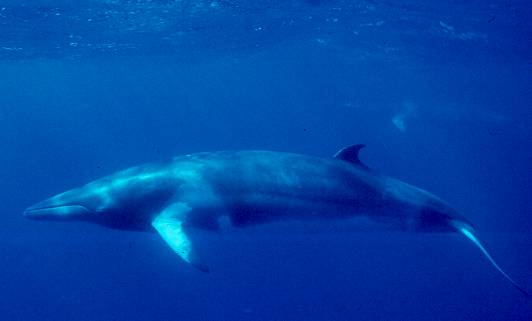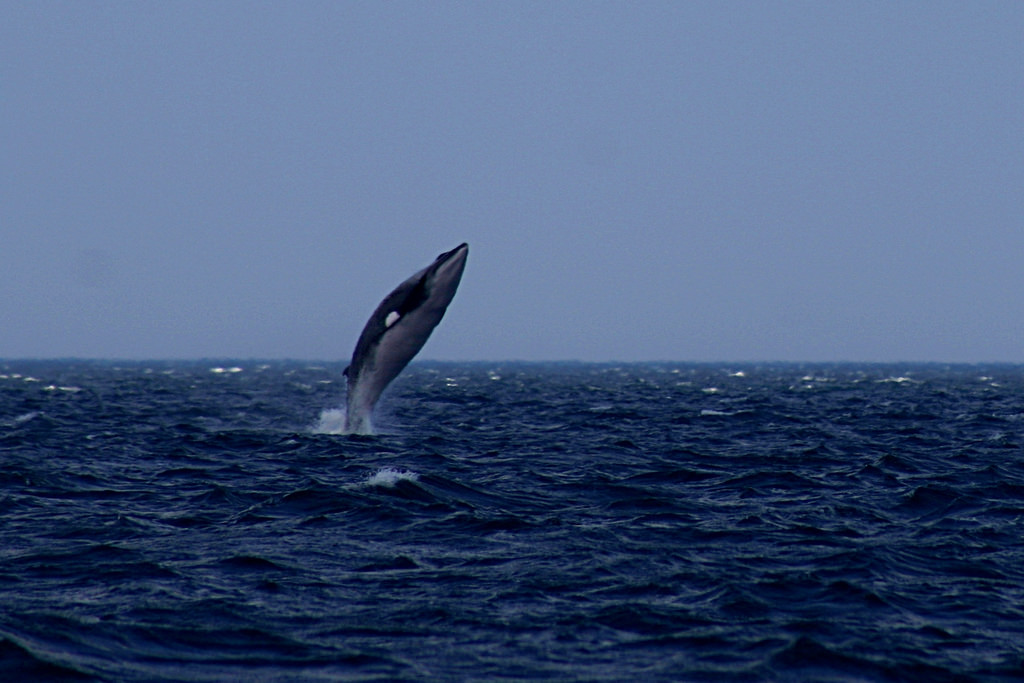A mysterious sound appears
For 50 years the source of a mysterious underwater sound plagued naval officers and marine acoustics researchers alike. Was it biological? Was it the sounds of deep underwater volcanoes erupting? Foreign submarines? The strange “boing” sound first appeared on submarine recordings off San Diego and Hawaii in the 1950s, but no one could figure out what the “metallic-like” ring they were listening to could possibly be. For decades, the navy continued to record this strange sound with no idea where it was coming from. Eventually, the answer to this mystery would give scientists new insight into the behavior of an elusive marine mammal.
It wasn’t until 1982 that researchers Thompson and Friedl finally hypothesized, based on when the sounds appeared and where they were recorded, that minke whales were producing these sounds. At this point, no one had actually seen whales in the vicinity of the recordings, so there was no way to be sure. Even if it was a whale, no one knew exactly which whale could be producing these boings across the North Pacific.

Marine bioacoustics: from submarine recordings to a whole new field in marine biology
Thompson and Friedl were able to hypothesize about the mysterious sound because of advances in the new field of marine bioacoustics. For the first time, in the 1970s and 80s, scientists actually started listening to the ocean. Bioacoustics research, the study of sounds produced by living creatures, was revolutionized by recording and analysis technologies which stemmed from methods used by the navy during World War II. Essentially, the study of whale and dolphin communication arose out of recordings of mysterious sounds, like the “boing,” which were recorded by sonar and antisubmarine warfare researchers. In fact, no one even knew that whales and dolphins were vocal animals until their calls were picked up by listening devices and increased underwater recording efforts during World War II. It was purely by accident that we found out marine mammals were talking to each other underwater, and a whole field of study grew out of a number of these opportunistic naval recordings.
Once bioacoustics research got started, it wasn’t long before humpback whale songs took the world by storm as simultaneous visual sightings and acoustic recordings allowed for a match of singer to song. For the boing sound of the 1950s, on the other hand, it took 50 years before anyone was able to match together visual sightings and recordings.
The mystery is solved
In 2001, scientists finally predicted which of the many whale species might be producing boings by comparing them to sounds made by dwarf and Antarctic minke whales. The similarities led to the hypothesis that minke whales produced boings in the North Pacific. At this point, no vocalizations had ever been recorded from North Pacific minke whales, so boings would be the first type of sound assigned to their repertoire. Minke whales are the smallest baleen whales and also the rarest in terms of visual sightings because they don’t spend a lot of time at the surface and don’t travel in large groups. Even though they’re hard to see, 50 years of boing recordings point out that they might be easy to hear.
Rankin and Barlow’s 2005 paper describes the minke whale recordings and visual sightings from their survey of whales and dolphins around the Hawaiian Islands. Aboard their ships, researchers positioned themselves with binoculars aimed at the surrounding waters and deployed their underwater recorders (hydrophones), which they towed behind the boat and listened to as sounds came in. For the first time, they were able to explicitly assign the boing sound to minke whales, a discovery 50 years in the making.

On November 7, 2002, Rankin and Barlow’s team recorded a series of boings and, by calculating the location of the source of each boing, followed the sound for an hour. Eventually, they were able to match up sightings of a baleen whale with localized calling sources. The team was rewarded with a breaching whale right near their boat which they confirmed was a minke whale. With the species identified, the team could move on to officially characterizing the types of calls made by the species and how those calls vary based on location.
By characterizing boing calls and attributing them to minke whales, Rankin and Barlow paved the way for future studies of minke whales. Because boings are detected so frequently, minke whales are easy to study acoustically, which makes up for the fact that they are rare and hard to study visually. Acoustically monitoring marine mammals is exciting for just this reason: we can use sound to study animals which are nearly impossible to study otherwise because we are restricted from ease of access to the underwater world.
I am a PhD candidate at Syracuse University studying marine mammal communication. My research focuses on analyzing underwater recordings of whale calls in order to better understand whale behavior. I’m also interested in education, outreach, and science communication. When I’m not listening to whale sounds, you can find me curled up with a good book or complaining about how much it snows in Syracuse.
